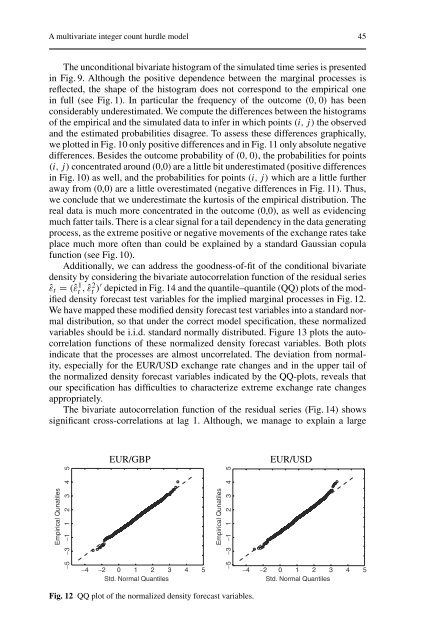recent developments in high frequency financial ... - Index of
recent developments in high frequency financial ... - Index of
recent developments in high frequency financial ... - Index of
Create successful ePaper yourself
Turn your PDF publications into a flip-book with our unique Google optimized e-Paper software.
A multivariate <strong>in</strong>teger count hurdle model 45<br />
The unconditional bivariate histogram <strong>of</strong> the simulated time series is presented<br />
<strong>in</strong> Fig. 9. Although the positive dependence between the marg<strong>in</strong>al processes is<br />
reflected, the shape <strong>of</strong> the histogram does not correspond to the empirical one<br />
<strong>in</strong> full (see Fig. 1). In particular the <strong>frequency</strong> <strong>of</strong> the outcome (0, 0) has been<br />
considerably underestimated. We compute the differences between the histograms<br />
<strong>of</strong> the empirical and the simulated data to <strong>in</strong>fer <strong>in</strong> which po<strong>in</strong>ts (i,j) the observed<br />
and the estimated probabilities disagree. To assess these differences graphically,<br />
we plotted <strong>in</strong> Fig. 10 only positive differences and <strong>in</strong> Fig. 11 only absolute negative<br />
differences. Besides the outcome probability <strong>of</strong> (0, 0), the probabilities for po<strong>in</strong>ts<br />
(i,j) concentrated around (0,0) are a little bit underestimated (positive differences<br />
<strong>in</strong> Fig. 10) as well, and the probabilities for po<strong>in</strong>ts (i,j) which are a little further<br />
away from (0,0) are a little overestimated (negative differences <strong>in</strong> Fig. 11). Thus,<br />
we conclude that we underestimate the kurtosis <strong>of</strong> the empirical distribution. The<br />
real data is much more concentrated <strong>in</strong> the outcome (0,0), as well as evidenc<strong>in</strong>g<br />
much fatter tails. There is a clear signal for a tail dependency <strong>in</strong> the data generat<strong>in</strong>g<br />
process, as the extreme positive or negative movements <strong>of</strong> the exchange rates take<br />
place much more <strong>of</strong>ten than could be expla<strong>in</strong>ed by a standard Gaussian copula<br />
function (see Fig. 10).<br />
Additionally, we can address the goodness-<strong>of</strong>-fit <strong>of</strong> the conditional bivariate<br />
density by consider<strong>in</strong>g the bivariate autocorrelation function <strong>of</strong> the residual series<br />
ˆεt = (ˆε 1 t , ˆε2 t )′ depicted <strong>in</strong> Fig. 14 and the quantile–quantile (QQ) plots <strong>of</strong> the modified<br />
density forecast test variables for the implied marg<strong>in</strong>al processes <strong>in</strong> Fig. 12.<br />
We have mapped these modified density forecast test variables <strong>in</strong>to a standard normal<br />
distribution, so that under the correct model specification, these normalized<br />
variables should be i.i.d. standard normally distributed. Figure 13 plots the autocorrelation<br />
functions <strong>of</strong> these normalized density forecast variables. Both plots<br />
<strong>in</strong>dicate that the processes are almost uncorrelated. The deviation from normality,<br />
especially for the EUR/USD exchange rate changes and <strong>in</strong> the upper tail <strong>of</strong><br />
the normalized density forecast variables <strong>in</strong>dicated by the QQ-plots, reveals that<br />
our specification has difficulties to characterize extreme exchange rate changes<br />
appropriately.<br />
The bivariate autocorrelation function <strong>of</strong> the residual series (Fig. 14) shows<br />
significant cross-correlations at lag 1. Although, we manage to expla<strong>in</strong> a large<br />
Empirical Qunatiles<br />
−5 −3 −1 1 2 3 4 5<br />
−4<br />
EUR/GBP EUR/USD<br />
Empirical Qunatiles<br />
−5 −3 −1 1 2 3 4 5<br />
−2 0 1 2 3 4 5 −4<br />
Std. Normal Quantiles<br />
Fig. 12 QQ plot <strong>of</strong> the normalized density forecast variables.<br />
−2 0 1 2 3 4 5<br />
Std. Normal Quantiles










